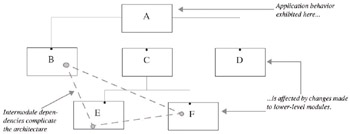The Dependency Inversion Principle
|
| < Day Day Up > |
|
When used together in a disciplined approach, the OCP and the LSP/DbC yield a desirable inversion of program module dependencies that is different from the usual top-down module dependencies attained with functional decomposition. This dependency inversion is generalized into a principle in its own right known as the dependency inversion principle (DIP). Robert C. Martin stated the definition of the DIP in two parts:
'A. High-level modules should not depend upon low-level modules. Both should depend upon abstractions.
B. Abstractions should not depend upon details. Details should depend upon abstractions.'
Characteristics of Bad Software Architecture
When a software module depends on the details of a lower-level software module it is hard to change and hard to reuse. Consider the software module hierarchy shown in figure 19-10 where high-level modules depend on low-level modules.

Figure 19-10: Procedure-Oriented Software Module Hierarchy
The behavior of module A depends on modules B, C, and D. The behavior of module C depends of the behavior of modules E and F. A change to module E affects module C which, in turn, affects module A. Any intermodule dependencies, such as global variables, will further complicate the issue. A complex software system sporting this sort of architecture will have the undesirable characteristics of bad design, namely, it will be fragile, rigid, and immobile.
A fragile software architecture is one that breaks in unexpected ways when a change is made to one or more software modules. Fragile software leads to rigid software.
A rigid software architecture is one that is so difficult and painful to change that programmers do not want to change it.
An immobile software architecture is characterized by the inability to successfully extract the software module for reuse in another system. The software module may exhibit desirable behavior but if it is too dependent on other modules or anchored to the application architecture by intermodule dependencies then it will be difficult if not impossible to reuse in another similar context. If it is easier to rewrite a module from scratch than it is to adopt and reuse the module then the module is immobile.
Characteristics of Good Software Architecture
Object-oriented software architectures that subscribe to the OCP and the LSP/DbC will depend heavily upon abstractions. These abstractions will appear at or near the top of the software module hierarchy. Refer again to the fleet simulation model class diagram shown in figure 19-9. The Vessel, Weapon, and Plant abstract base classes serve as the foundation for all behavior inherited by the lower-level implementation classes. This inheritance relationship means that the lower-level derived classes are dependent upon the behavior specified by the higher-level base class abstractions.
The key to success with the DIP lies in choosing the right software abstractions. A software architecture based upon the right kinds of abstractions will exhibit the desirable characteristic of being easy to extend. It will be flexible because of its extensibility, it will be non-rigid in that the addition of new functionality via new derived classes will not affect the behavior of existing abstractions. Lastly, software modules that depend upon abstractions can generally be reused in a wider variety of contexts, thus achieving a greater degree of mobility.
Selecting The Right Abstractions Takes Experience
The ability to identify essential software component abstractions takes practice and experience. However, applying the OCP and the LSP/DbC in your object-oriented software architecture design will yield a better design, even if you do not get all the abstractions right the first time around.
Quick Review
The OCP and the LSP/DbC, when applied together, result in the realization of a third design principle known as the dependency inversion principle (DIP). The key to the DIP is that high-level software modules should not rely on low-level details, and that software modules at all hierarchy levels should rely only upon abstractions. When a software architecture achieves the goals of the DIP it is easier to extend and maintain (flexible and non-rigid). Software modules that conform to the DIP are easier to reuse in other contexts (mobile).
|
| < Day Day Up > |
|
EAN: 2147483647
Pages: 340